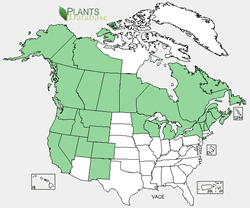Plant of the Week
 Vaccinium cespitosum range map. USDA PLANTS Database.
Vaccinium cespitosum range map. USDA PLANTS Database.
 Dwarf bilberry (Vaccinium cespitosum, showing ripe fruit. Photo by Sue Trull, Ottawa National Forest.
Dwarf bilberry (Vaccinium cespitosum, showing ripe fruit. Photo by Sue Trull, Ottawa National Forest.
 Dwarf bilberry growing with lichens, McCormick Wilderness, Michigan. Photo by Sue Trull, Ottawa National Forest.
Dwarf bilberry growing with lichens, McCormick Wilderness, Michigan. Photo by Sue Trull, Ottawa National Forest.
 Northern blue (Lycaeides idas nabokovi) on dwarf bilberry (Vaccinium cespitosum), Ottawa National Forest, Michigan. Photo by Sue Trull, Ottawa National Forest.
Northern blue (Lycaeides idas nabokovi) on dwarf bilberry (Vaccinium cespitosum), Ottawa National Forest, Michigan. Photo by Sue Trull, Ottawa National Forest.
Dwarf Bilberry (Vaccinium cespitosum Michaux)
By Sue Trull, Botanist Ottawa National Forest
Dwarf bilberry is a small shrub of mainly northern distribution. A member of the heath family (Ericaceae), bilberry is many-branched, 2 to 20 inches tall, and forms low mats as it spreads by runners or stolons. Bilberry has alternate, small, oval leaves, widest above the middle, with a pointed tip. Leaves grow up to 2 inches long, and are green on both top and bottom, with the bottom paler in color. The leaf edges have tiny teeth. The leaves are sessile or have very short stems. The leaves turn reddish-brown and drop off in the fall, leaving the plant to overwinter as twigs and underground rhizomes. Dwarf bilberry’s branches are somewhat angled or ridged. They are thin, green to tan or reddish when young, and gray-brown when older. Bilberry roots are fibrous and spreading.
The bilberry flowers are waxy, white to pinkish-red, and bell-shaped, with five united petals. The flowers occur singly, hanging from the axils of lower leaves, unlike true blueberries that have flowers in clusters. The flowers bloom in May to June, and are pollinated by bees and flies. Dark blue berries develop from the flowers by mid-summer. The berries have a whitish “bloom”. They are similar to a commercial blueberry, but smaller, and without the little crown of sepals present on a blueberry. Bilberries are sweet, tasting much like a blueberry. Grizzly and black bears, some small mammals, and many birds eat the fruit, as do people. Seeds are tiny, with many in each berry.
Dwarf bilberry has threatened status in Michigan, and is considered endangered in Wisconsin and New York, all states at the south end of the bilberry’s range. In the Great Lakes area, bilberry is usually found in savannas or openings within conifer forest, on sandy soils or thin soils over rock. Farther into its range, bilberry is common, an understory dominant in higher elevation spruce-fir forest, for example. It can also occur in alpine heath and in shrublands formed in areas of persistent snow cover. It often grows with other Vaccinium species, such as lowbush blueberry (Vaccinium angustifolium) and other heaths, such as wintergreen (Gaultheria procumbens), Labrador tea (Ledum groenlandicum), and bearberry (Arctostaphylos uva-ursi).
Dwarf bilberry is the host plant for the northern blue butterfly, Lycaeides [Plebejus] idas nabokovi. The subspecies was named for the novelist Vladimir Nabokov, who was also an entomologist specializing the the tribe of butterflies to which the blues belong. The northern blue is listed as endandered in Wisconsin, threatened in Michigan, and special concern in Minnesota. In the Great Lakes area, northern blue caterpillars only consume dwarf bilberry although adult butterflies also use other plants. Some surveyors key in on the presence of the butterfly to find the easily overlooked bilberry mats.
The Ottawa National Forest, in the western Upper Peninsula of Michigan, has initiated an active recovery program for both the bilberry and butterfly. Bilberry plants are raised from seed at the Forest Service’s J.W. Toumey Nursery, and then planted in suitable openings on the Forest. Longer-term plans call for adding northern blue caterpillars once bilberry populations are established.

